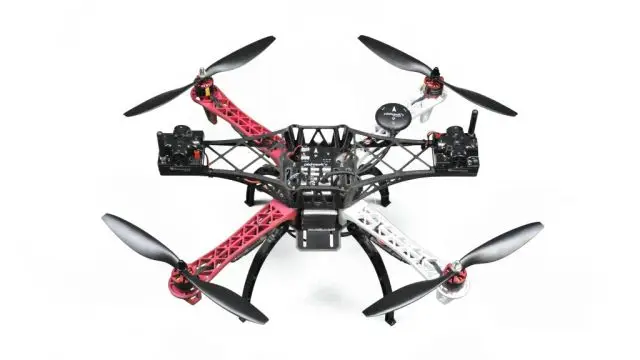Automated scanning and inspection
Autonomous robots, drones, and real-time locating systems for warehouse and factory automation
It is what machines can do very well, but humans are prone to tiredness and errors.
Executive Summary:
- Autonomous robots are ready for inspection work today
- Today's automation solutions are still too labor-intensive
- Drones are great in theory but challenging in practice
Study more below.
Robotic solutions for automated scanning and inspection
Autonomous robots come in different forms
Different tasks require different shapes and sizes from the robot. Like mammals can be very different in appearance, for example, mice and elephants, their internal structure is still very similar.
The same is true for robots: they use similar architecture, software, and even electronics but may be very different in size and shape to do their job most efficiently.
Thus, remember that shown examples are simply examples. Robots can be relatively easily tuned for your needs and requirements. Share them via info@marvelmind.com.
Autonomous robot Boxie Scanner
Autonomous robots for scanning
We love drones. Drones are advanced and cool.
However, when we think about something reliable, predictable, and fault-proof that just does the job – automated scanning and inspection – autonomous robots seem to be a more feasible solution.
- Drones crash sooner or later
- Crushes are expensive
- Crushes are potentially dangerous
- Drones require 3D tracking - more complex/expensive
- Rather limited working time due to batteries
- If everything goes wrong, robots simply stop driving
- Robots are inherently safer than drones
- Robots require 2D tracking - less expensive than 3D
- Can work 8/16/24h or more between re-charges
- Power consumption of payload is not a problem
- Size of scanning equipment is not a problem
Types of scanning and inspecting equipment:
- Cameras on different levels for parallel scanning
- RFID readers
- Barcode readers
- QR code readers
- Additional lighting for optimal performance
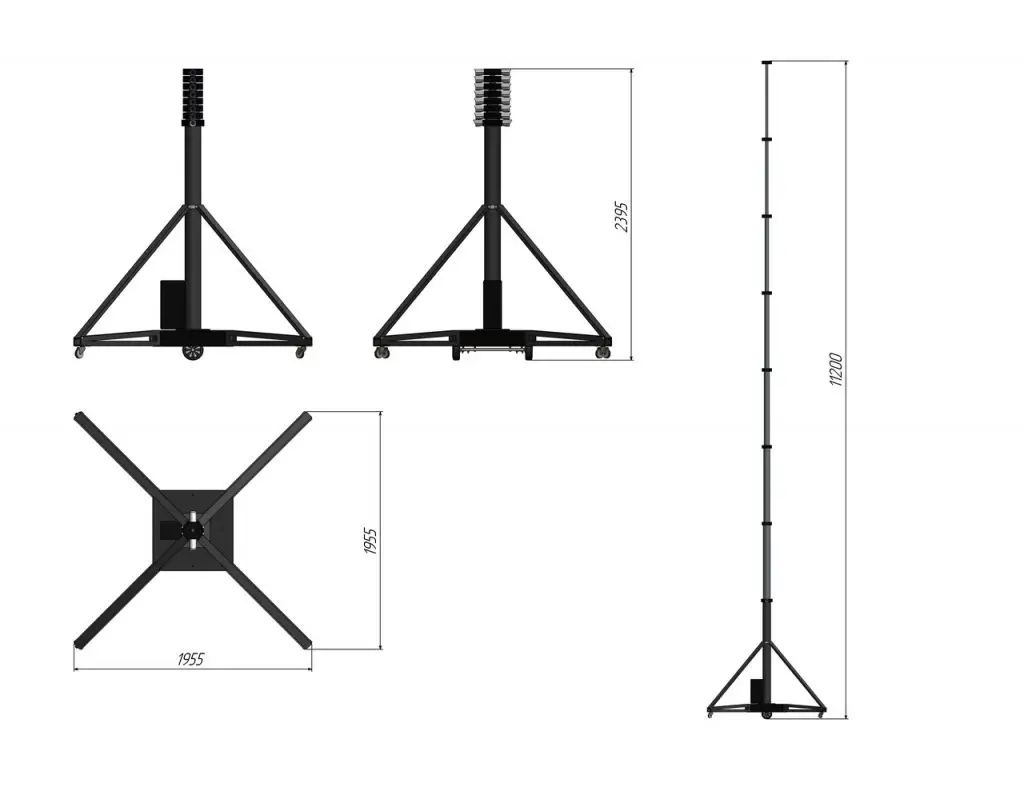
Key features
- Task
- Area
- Quantity
- Autonomous
- Indoor only
- Operations
- Battery lifetime
- Robot cost
- Automated scanning
- Warehouse, plant, airport
- Multiple robots
- YES
- YES
- Daily, weekly
- 8/12/16 hours
- 6,990 - 14,990 EUR
Benefits
- Increased productivity and efficiency
- Improved inventory control
- Reduced human errors
- Minimized manual labor
- Enchanced data accuracy
- Reduced count cycle
- Reduced inventory loss
Technology
- Integration with various WMS and ERP
- Autonomous driving
- Obstacle detection and avoidance
- Wireless connectivity
- Real-time performance tracking
Capabilities
- Support of different types of scanners
- Configurable dimensions
- Configurable battery capacity
- Configurable battery size for payload
- Easy to deploy and operate
Boxie is a small autonomous mobile robot (AMR) used as a platform, carrier, or tractor for scanning, inspecting, and monitoring equipment – for your payload, whatever form it has. Not only can Boxie carry your payload from point A to point B (C, D, E, etc.) and back, but it can also supply your equipment from the internal batteries and control your equipment by getting commands from your central controllers via our internal wireless network.
Think about our robots – Boxie Scanner and Boxie Scanner Mini – as rockets where you place your satellites (payload), and they deliver your payload to wherever you wish.
Warehouse automation: basics
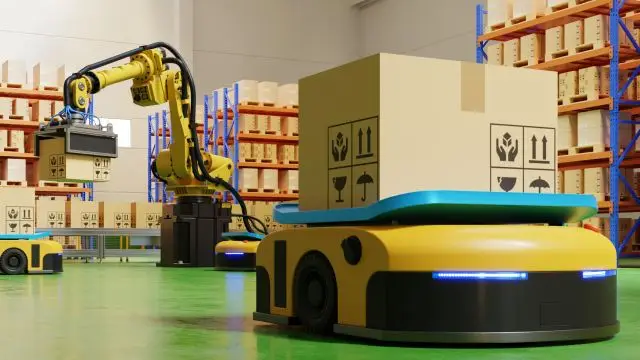
Warehouse automation, as well as factory automation, is a gradual process coming in steps and multiple forms:
- Integrating with WMS or ERP
- Tracking assets in all stages
- Assets handling inside the warehouse
- Inventory counting and controlling
- Optimizing assets utilization based on real-time data
Tasks for automated scanning and inspection solutions
- Reduce chances and probabilities of inventory loss
- Speed up lost inventory localization and recovery
- Provide automated scanning, including scheduled scanning
- Reduce the need for manual labor: scanning, walking, data entry
- Minimize inventory accounting errors
- Increase quality and reliability of inventory and assets data
- Improve capacity utilization
- Increase productivity and efficiency
Greenhouse inspection
Not only warehouses or factory floors require automation. Many other industrial areas need predictable and repetitive scanning and inspection, for example, greenhouses.
Greenhouses want to monitor vegetation process and apply sprinkling or initiate cropping just in time.
They also need detailed statistical data to analyze and predict. It requires a lot of data gathering over time that must be trusted and relied upon.

Autonomous robots are perfect for automated greenhouse scanning and monitoring.
Autonomous drones can also be used for greenhouse scanning. However, the apparent flexibility and capability of the drones come along with potentially lower reliability and higher risks of failure due to the complexity of the technology.
Automated scanning in retail
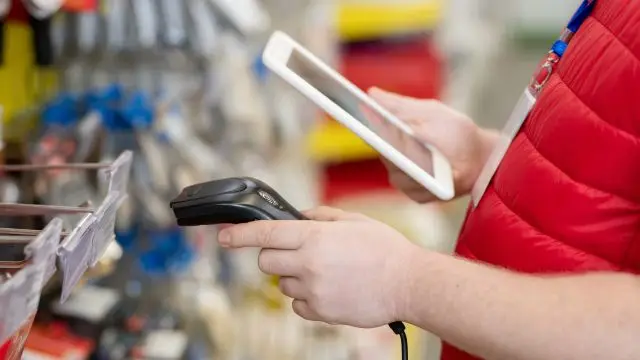
Not only industrial environments or greenhouses require automated scanning and inspection of assets, inventories, or growing vegetable. It is a fundamental task for retail as well.
The requirements in retail are even more demanding because the stocks vary in form, shape, color, and type a lot. Also, it is essential to monitor not only the stock availability and location in general but their appearance, quality of the package, etc.
Marvelmind Robotics currently focuses on industrial applications. Thus, we don’t offer solutions for retail now. However, the same solutions, technologies, and architectures of automated scanning and inspection used for industrial applications can be used in retail with relatively minor modifications. The back-end solutions (image/object recognition, etc.) for retail are more complex than for industrial applications due to the less structured environment and presence of the general public as opposed to instructed workers in warehouses or plants.
Classical solutions for warehouse automation
Classical solutions for warehouse automation still heavily rely on humans. Yes, readers, scanners, and trackers are available and enabling accountability and traceability of assets and what has been done or not done. Yes, WMS and ERP provide the databases and records. But many tasks – real physical scanning and real physical movements – are still done by humans with all their pros and cons. The task remains labor-intensive.
Before diving into advanced warehouse automation solutions, let’s briefly touch on what warehouses are using today.
Barcode readers and QR code scanners
Using barcode readers is probably the first real stage of practical automation that allows the handling of a large amount of inventory quickly and reliably.
Humans still have to bring the scanners to assets and inventory to read the data. Sometimes, assets are moved to humans by a conveyor or AGVs.
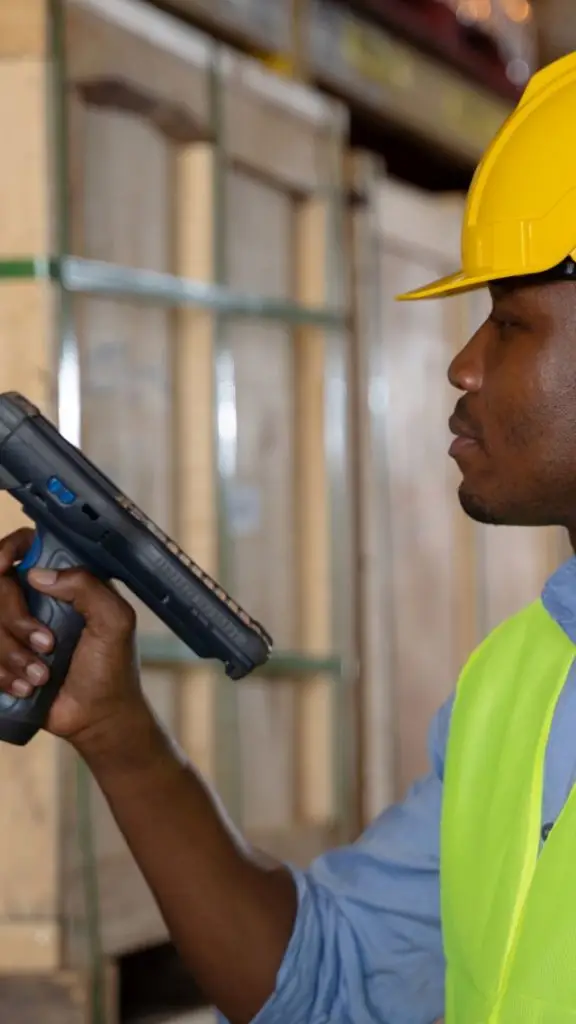

Active RFID offers a rudimentary gate-level real-time locating system. You don’t know the exact location of an asset at any given time unless you read it right now and you know the location of your RFID scanner, but you can well localize your assets to some level based on the path of the asset through the gates with RFID readers.
RFID readers and RFID scanners
The RFID solutions are divided in passive and active RFID:
- Passive RFID: no battery inside; reading up to ~10cm
- Active RFID: battery inside tag; reading up to ~10-100m
The RFID solutions are very similar to barcoding in usage. Still, the technology behind it is entirely different. RFID is more flexible and more advanced than barcodes or QR codes. More data can be stored inside an RFID tag, and the data can be changed electronically – no need to print or stick.
However, even passive RFID tags are typically more expensive than basic bar code or QR code labels. Active RFID tags are significantly more expensive and require either a battery inside that must be charged or changed periodically or a fixed external power supply to power the active electronics inside the tag. In short, active RFID tags are orders of magnitude more complex than basic bar/QR code labels.
At the same time, the labels and readers are only a small part of the whole warehouse automation system. Thus, if the total cost of the system (WMS/ERP, labels and labeling, scanners, people, ease of use, flexibility, availability of data, etc.) is taken into account, even active RFID tags or RTLS become a viable solution.
Active RFID solutions allow the distance to read your assets’ data to be larger – tens and hundreds of meters from a reader. You don’t yet know the location of your assets because RFID is not a true real-time locating system (RTLS), but you can retrieve a lot of data from multiple RFID tags without needing physical movements toward the assets.
With proper arrangements, RFID, and particularly active RFID, is an effective solution for multiple applications because it offers reasonable accountability and traceability of inventory and assets in general.
Key elements of automated scanning solutions
Before we dive deeper into discussion of how to implement automated scanning and inspection solutions, let’s highlight what the key elements of automated scanning solutions are.
- Worker walks and scans
- Handheld scanner/reader
- Worker interprets readings and makes decision
- Manual, limited
- Monthly, quarterly, yearly
- Autonomous robot or drone
- Multiple scanners wirelessly connected with WMS
- AI recognizes and makes decision
- Everything is recorded: what, where, when
- Daily, hourly, constantly
Advanced solutions for warehouse automation
The key task of automation is to eliminate manual labor and substitute it with other solutions wherever possible. In its turn, it will lead to reduced human error, reduced labor and operational cost, improved customer service, and even improved employee satisfaction.
Automated scanning and inspection is a relatively simple task for modern autonomous technologies, and it shall free people to do other – less monotonous and repetitive – work.
Advice: succeed with scanning robots first and then advance to drones
Drones for inspection
We at Marvelmind Robotics are approached with requests for autonomous drones or indoor positioning systems for autonomous indoor drones for warehouse inspection, automated barcode scanning, or RFID reading, at least, on a weekly basis.
There is certainly a solid need for the task and a strong interest in fulfilling the need based on drones.
Autonomous drones for warehouse inspection is probably the most complex solution to implement in practice among typical automation technologies. Let us start with it and then consider alternatives to drones.
What is challenging with drones in general?
- Cost of mistakes is high - drones crush
- Drones are potentially dangerous
- They require either a pilot or advanced 3D (XYZ) RTLS
- More advanced drones are even more expensive
Manually controlled drones
The first and rather primitive way to scan assets using drones is to fly them manually. It is a straightforward solution that obviously works if the drone pilot is skillful. The system can be deployed quickly if there are already back-end systems in place: WMS, ERP, image or video recognition, AI, etc., that are required for all kinds of warehouse and factory automation systems – autonomous or manual drones – anyway.
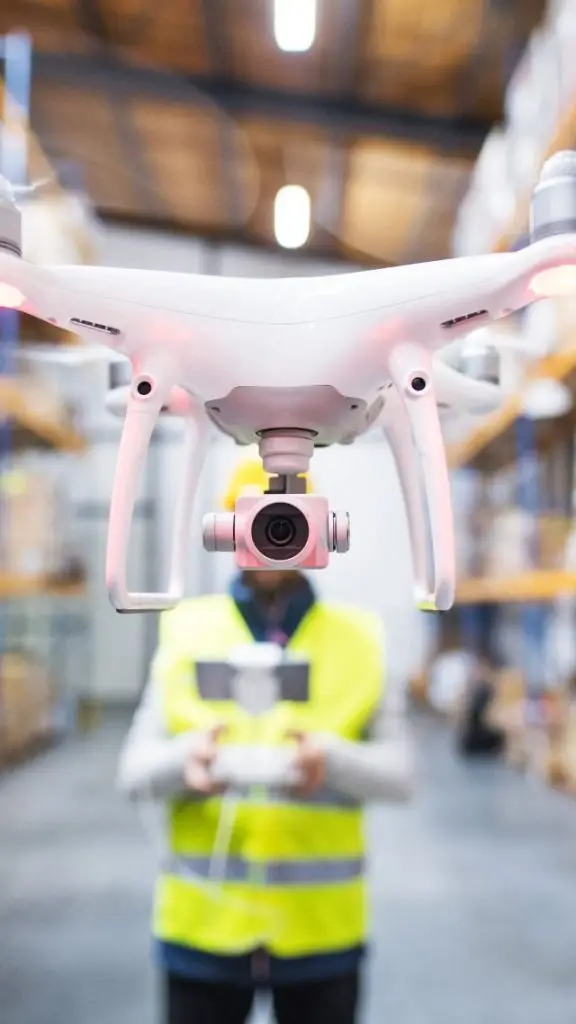
- Easy to deploy and less expensive for minor inspections
- Pilot is always in control
- Possibility to fly even in an unprepared environment
- Need for a pilot
- More expensive than autonomous drones in the long run
- Data is less accurate and repetitive
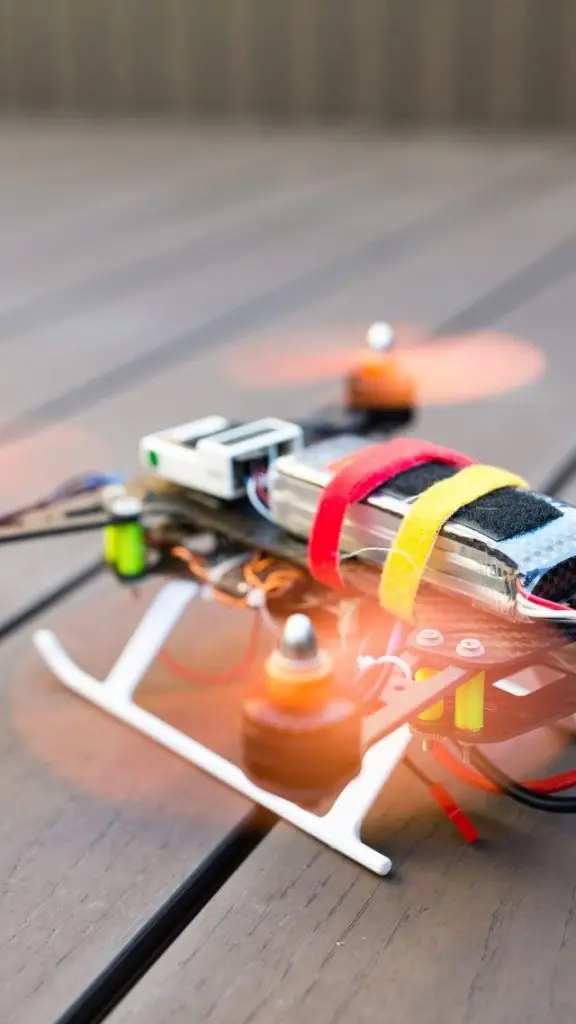
When we talk about automation, we dream about something that works with little or no human interventions. We also expect that the system works at least as reliably and predictably as with humans in the loop. And, of course, it must be more efficient. Otherwise, what is the point of automation at all.
However, SLAM is a fancy technology for research but not necessarily the best one when something practical – like scheduled inventory counting – shall be performed. SLAM is perfect for discovering the environment, building a map of it, and using it for an autonomous flight. But what is the value in re-discovering, again and again, the same warehouse for the expense of complexity and lower reliability than other methods of localization.
Thus, a real-time positioning system that relies on infrastructure or external markers assisting the drone in autonomous flight is the most cost-efficient and reliable solution for real practical implementation. Which indoor positioning system is the most suitable for a particular case depends on the case.
- Perfect for scheduled scanning and inspection
- Lower cost per asset in the long-run
- Independence from the pilot's schedule/availability
- High cost of mistakes - drones crush
- Potentially dangerous
- Typically, require infrastructure/RTLS to fly
How to build autonomous indoor drone
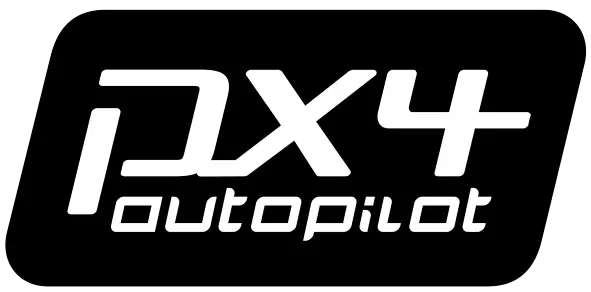



We discuss in depth how to build autonomous indoor drones on our Drones page.
Below are essential hints relevant to automated scanning using autonomous drones:
- Build own drone from readily available components
- Take the best component from each source
- Use open-source hardware (PixHawk, etc.)
- Use open-source software (PX4, PixHawk)
- Use open-protocol RTLS (Marvelmind)
- Find a drone integrator or become the integrator
- Shy away closed systems - DJI, etc. - beautiful and appealing, but restrictive and limiting in the long-run
- Try DJI, etc. modules, though: cameras, gimbals
- Deeply hack DJI SDK - it may be a good solution
Indoor positioning systems for autonomous drones
Pros:
- – Highest accuracy among indoor RTLS
- – Reliable RTLS solution
- – Incremental cost per drone is low
- – Infrastructure can be used for other tasks
- – Relatively simple drones
- – Accuracy doesn’t depend on the distance
Cons:
- – Requires complex infrastructure
- – May have problems with ultrasound noise
Pros:
- – Reliable RTLS solution
- – Incremental cost per drone is low
- – Infrastructure can be used for other tasks
- – Relatively simple drones
- – Accuracy doesn’t depend on the distance
Cons:
- – Requires complex infrastructure
- – ~10 times less accurate than ultrasound
- – May have difficulties with Z coordinate
Assisted optical (QR codes)
Pros:
- – Rather simple to implement
- – Ready-to-use SW libraries available
- – Basic hardware requirements
Cons:
- – Require QR code labels everywhere
- – QR codes on the floor are easily blocked
- – QR codes on the floor are easily damaged
- – QR codes on the ceiling are impractical
- – Heavily depended on lighting
- – Accuracy drops with distance
SLAM optical
Pros:
- – Can work in an unprepared environment
- – Combine positioning and obstacle detection
Cons:
- – Less reliable than some other methods
- – More complex than some other methods
- – Requires advanced/expensive camera(s)
- – Requires advanced processing/connectivity
- – May accumulate positioning error
- – May be heavy
SLAM LIDARs
Pros:
- – Can work in an unprepared environment
- – Combine positioning and obstacle detection
Cons:
- – Simple LIDARs are not very capable
- – Complex LIDARs are heavy and expensive
- – May depend on lighting
- – May be less reliable in complex environment
Implementation of an indoor positioning system for autonomous drones in warehouses with narrow aisles
Marvelmind Robotics is, first of all, a precise indoor positioning system provider for autonomous robots and drones. Thus, we can guide you in depth about implementation of your autonomous indoor drone project whether you build it on Marvelmind indoor positioning solutions or other solutions. Many recommendations and requirements are very similar.
In the video above, we talk about NIA. If you need to fly multiple drones simultaneously, use MF NIA as your indoor drone positioning system. With up to 8 drones simultaneously, MF NIA provides the same location update rate per drone as for one drone. With even more simultaneously flying drones, even more advanced methods on top of MF NIA may be offered. Let us know via email: info@marvelmind.com
– Defines the requirements
– Сhooses integrator and vendors
– It can be an integrator as well
– Ultimately responsible for the project
– Integrates products and solutions from different vendors, for example, Marvelmind Robotics
– Supplier of accurate indoor positioning systems (IPS) and RTLS for autonomous robots and drones
– Supplier of autonomous robots for automated inspection and scanning
– Closely cooperating with the end-user, integrators, and other providers, for example, drone and AI providers
– Closely cooperating with suppliers of barcode and QR scanners, RFID readers, and similar equipment
– Selected by the end-user or the integrator. Can be referred by Marvelmind Robotics based on previous integrations
– End-user and integrator can be drone providers as well
– In many cases drones are assembled from the off-the-shelf basic components: frame, motors, autopilot HW/SW
– Responsible for QR, barcode, image, object recognition, machine learning, and RFID data interpretation
– Responsible for integration with WMS/ERP

